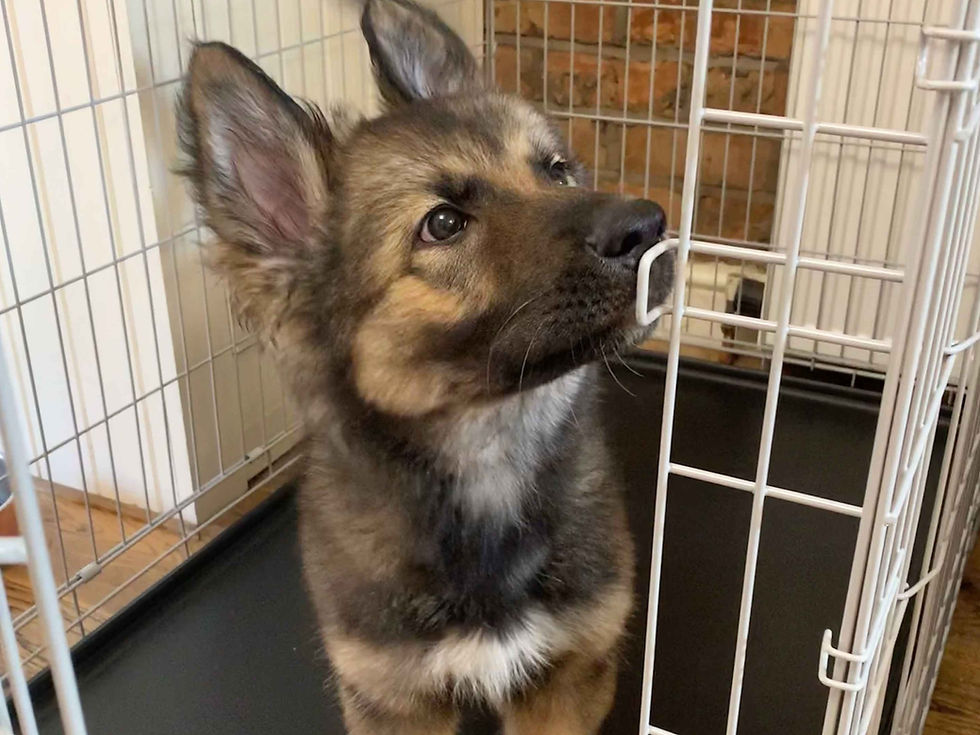How To Crate Train Your Dog
- dogsofjupiter
- Oct 4, 2023
- 4 min read
Updated: May 28

Crate training! My all-time favourite for lots of reasons but primarily: safety. A crate is effectively a bedroom for your dog and just like you put your baby to bed in their crib to keep them safe when unsupervised, a crate works exactly the same way for your dog.
When your dog is crate trained and tucked up in their crate when you nip out they can't get themselves into trouble. Things I've seen unsupervised dogs be rushed to emergency vets for: they chewed open an inhaler, they ate some onions out of the bin, they ate rubber bands which got stuck around their intestines, they chewed the sofa and ate the stuffing, they ate chocolate from the counter... you get the picture. This doesn't even include dogs that have endangered themselves chewing electrical cables, have done hundreds of pounds of destruction by pulling up carpets and wallpaper or have toileted all over your home.
Crates keep dogs safe while unsupervised and I haven't even touched on how beneficial they are for training. They create an opportunity for you to teach your dog how to rest and relax independently. Puppies especially benefit from crates because they often become over-tired and cranky, like a toddler, and crate training gives you a way to make sure they're sleeping when they need to.
I firmly believe that all dogs should be crate trained, even if your dog is perfect in the home they may need to be crated or kennelled at a vet, at a groomer, at a boarder, or if they need crate-rest following an injury or surgery. All of these instances are going to have a lot of added stress if they've not had prior crate training.
So how do we do it? Here's our How To Crate Train guide, taken directly from my 'things for clients' work folder.
HOW TO CRATE TRAIN YOUR DOG
First up, let's put down some House Rules
- The crate is not a punishment. It is a safe place.
- Your dog should be able to stand up and turn around in their crate. Do not get a crate too large for them (especially puppies, they may toilet in a corner)
- Make sure your dog has toileted before putting them in their crate
- Never let your dog out if they are whining/barking. They will view the release as a reward and learn that barking = reward. Wait until they are quiet for at least 5 seconds before letting them out at first, that way calm = release = reward.
- Use your dog’s meals to crate train: (see Hand Feeding)
- You will need your reward and release marker words for this: (see Clicker Training)
- Most dogs will struggle to settle in a crate in a busy area with things going on. Try to put their crate somewhere quiet for them
- They don't need toys in there. We want them to settle and rest, not get hyper and play
- I rarely leave water in there. If they knock it over they're going to be uncomfortable. They're never in a crate long enough for water access to become an issue
- If they chew their blankets, remove them
1) We're going to start the same way we start everything, marking and rewarding your dog for showing interest in the crate. Every time they look at, sniff at or walk in the crate, mark and reward.
2) We now want them comfortable entering and remaining inside the crate. Lure them inside it with food and mark and reward when they get inside. Mark and reward them for remaining inside. Use your release marker and lure them back out. This can be a full session (5-10 minutes, until their food portion runs out) if necessary.
3) They're now comfortable entering and remaining in the crate so push the door over and mark and reward through the door. Build up the spacing between rewards and build up your distance from the crate, walk around the room and then come back and reward them for remaining calm.
4) When they're comfortable with the door being closed, bowl feed (or scatter feed) their meals in there and leave the room. You can also give them a chew in there. When they finish the chew or the meal, wait a couple of minutes before releasing them, so they get used to spending time in there.
5) Build up to leaving them alone for small amounts of time. A dog whining for ten minutes before giving up is a dog that needs to be left alone, a dog that barks and howls for over an hour is a dog that either isn't fully crate trained yet or has separation anxiety that needs to be treated.
6- Bonus) If your dog falls asleep outside of their crate, transfer them into it to build their connection with it as a bed. This works especially well for puppies.
That's it! If your dog doesn't have separation anxiety but struggles in the crate, rewind these steps and see if you can find which bit they're struggling with. A crate should be their cosy bedtime nap space, just like humans have a bedroom and babies have cribs. You can get very fancy wooden home style crates if the traditional wire crate look puts you off. Dogs are natural den animals though so they will love their crate space, try not to humanise it!




Comments